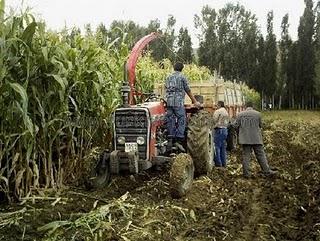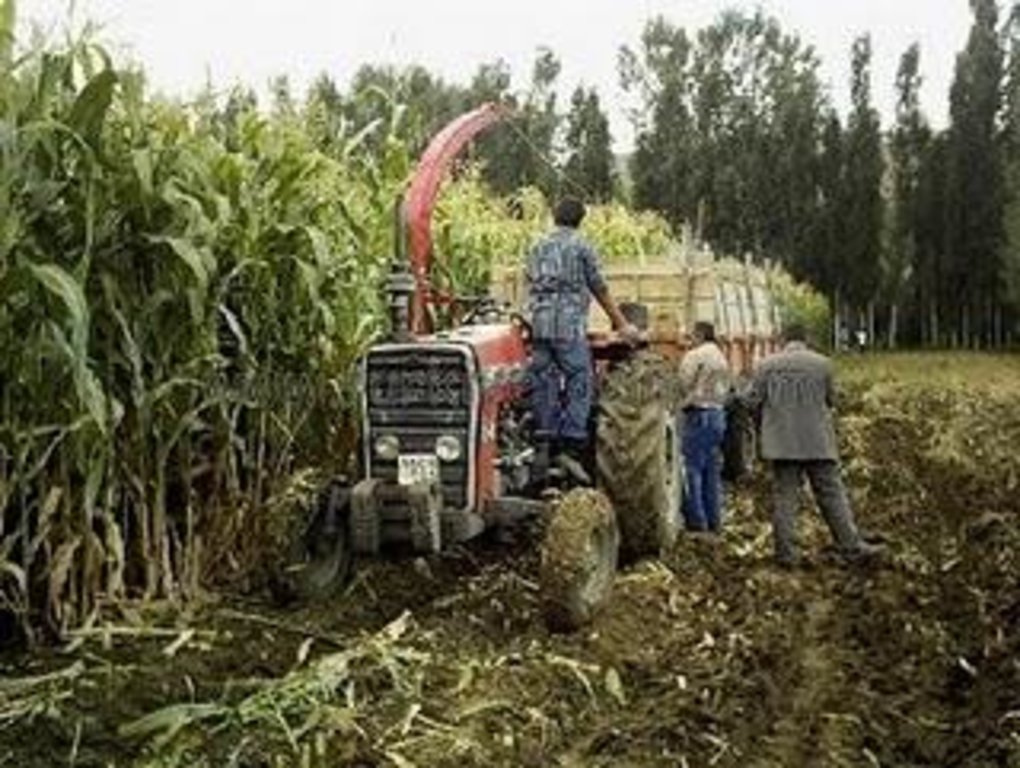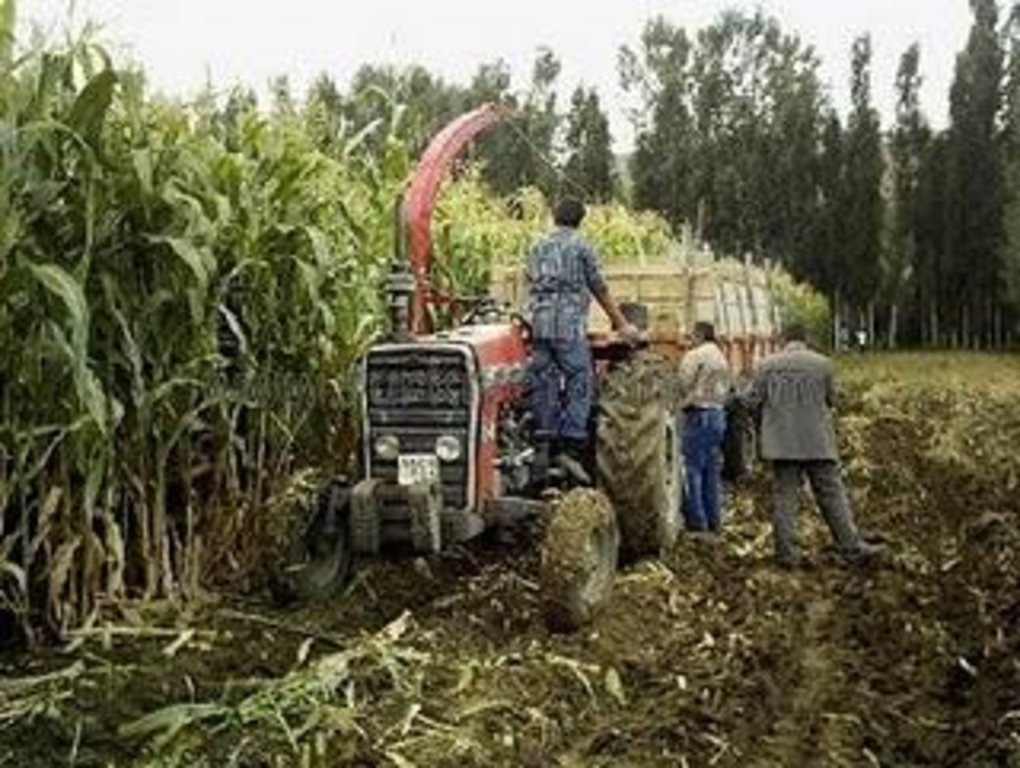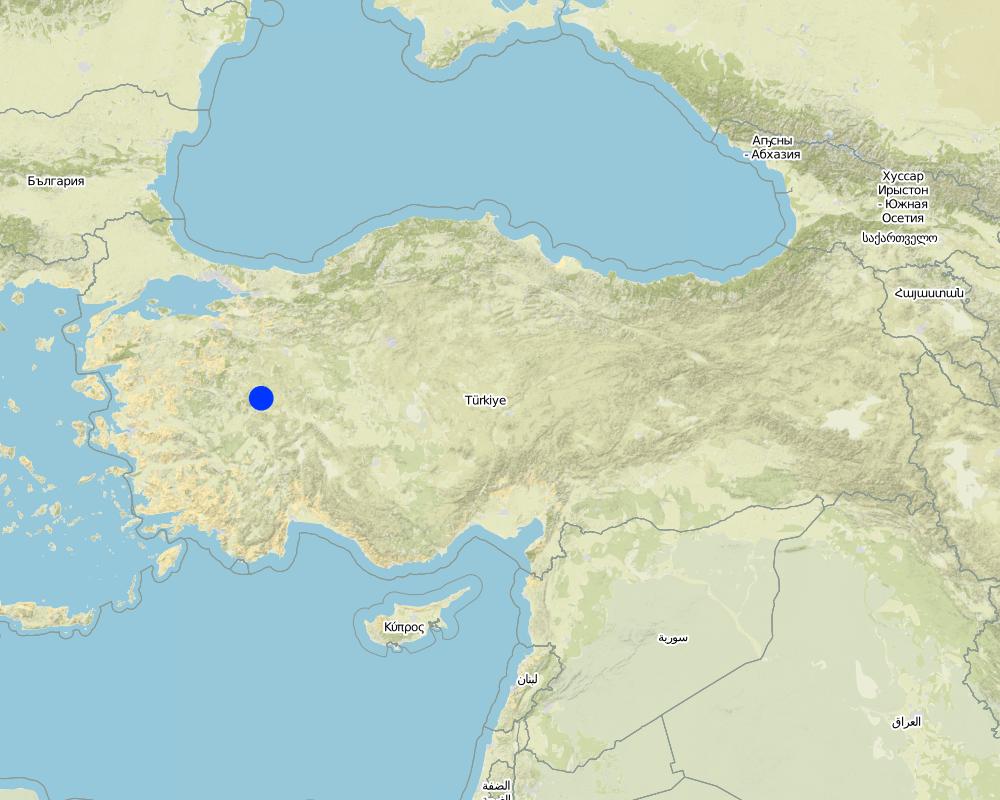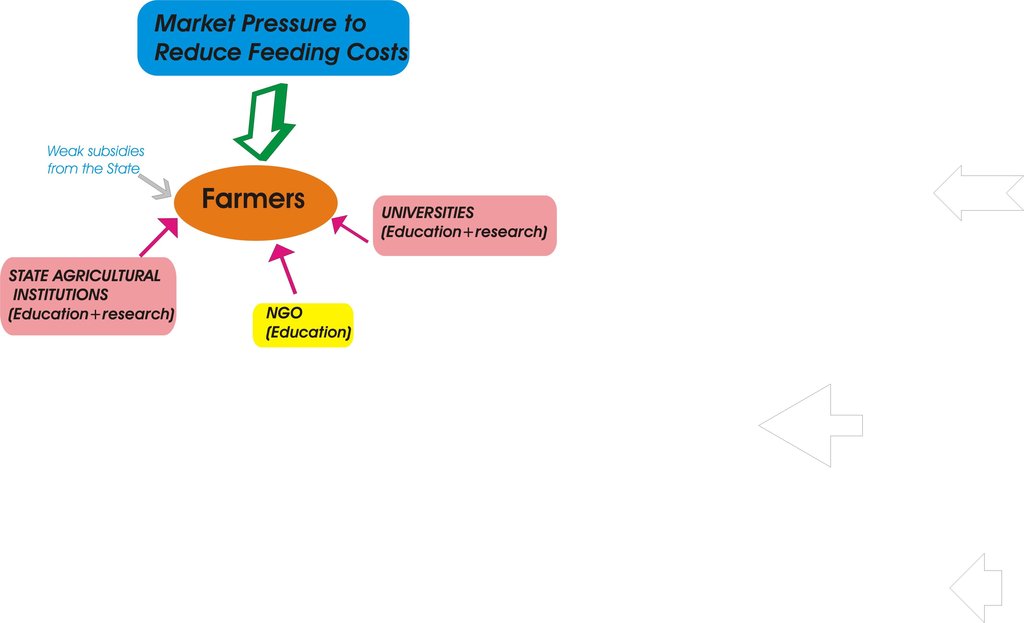Fodder Crops Production [Türkiye]
- Creation:
- Update:
- Compiler: Unknown User
- Editor: –
- Reviewer: Fabian Ottiger
approaches_2425 - Türkiye
View sections
Expand all Collapse all1. General information
1.2 Contact details of resource persons and institutions involved in the assessment and documentation of the Approach
Key resource person(s)
SLM specialist:
Tolay Inci
Türkiye
1.3 Conditions regarding the use of data documented through WOCAT
The compiler and key resource person(s) accept the conditions regarding the use of data documented through WOCAT:
Yes
1.4 Reference(s) to Questionnaire(s) on SLM Technologies
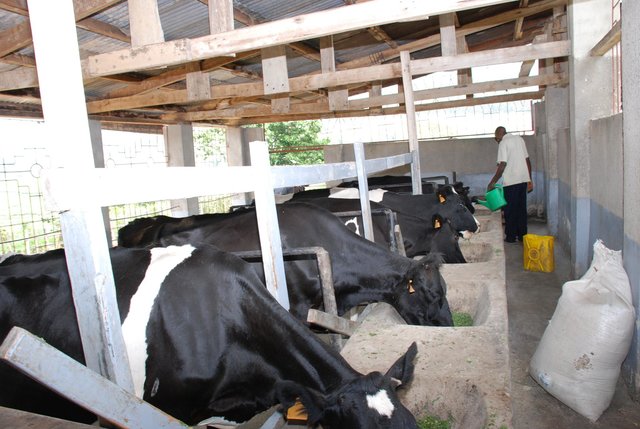
Dairy cattle fed with supplementary fodder [Uganda]
Elephant grass (Pennisteum purpureum) and calliandra (Calliandra calothyrsus), are harvested and chopped using a chaff cutter to produce fodder for dairy cows. The chaff is then mixed with cotton seed cake, molasses and maize bran to improve palatability and nutrient quality for dairy cows. The cattle graze in paddocks during …
- Compiler: Aine Amon
2. Description of the SLM Approach
2.1 Short description of the Approach
To grow different fodder crop species (leguminous and graminous) for feeding livestock
2.2 Detailed description of the Approach
Detailed description of the Approach:
Aims / objectives: It is aimed to grow livestocks feed for reduce costs of inputs in farms. Ease of feeding by this way is another motivation. Fodder crops especially leguminous ones are also very useful for improving and protecting soil fertility. Therefore farmers who produce both crops and livestock prefer to grow fodder crops.
Methods: Leguminous (alfaalfa, soinfoin, vetch) and graminous (corn for silage, barley, wheat, oat, triticale, rye) fodder species are grown in different growing seasons. Graminous fodder species are grown annually, among the leguminous species. Alfaalfa, sainfain are perennial and vetch is an annual species. The fodder species can be grown under dry conditions except corn. Leguminous species can not grow well if there is not enough rainfall; therefore they need irrigation. Application of the approach is mostly forced by market conditions where meat incomes were gradually decreasing in the last years due to macroeconomic policies. Training of the farmers is achieved by state institutions, universities and NGO's in a rather discontinous and sporadic way.
Stages of implementation: Soil tillage, fertilizing the soil, sowing the seeds, irrigation, harvest (1 for graminous species several times for leguminous species). Starting the approach by individual farmers is done by traditional communication and sometimes by training activities.
Role of stakeholders: All stages of the technology application are performed by participants. Technology is applied by farmers who have all the facilities needed for technology. They get some subsidizes from the state because of promoting the fodder crop production. State organisations, universities and NGO's provide irregular training courses and demonstrations. Rare scientific studies in terms of advantages of approcah are conducted by universities and state research institutes.
2.3 Photos of the Approach
2.5 Country/ region/ locations where the Approach has been applied
Country:
Türkiye
Region/ State/ Province:
Turkey
Further specification of location:
Keskin watershed, EskiÅŸehir
Map
×2.6 Dates of initiation and termination of the Approach
Indicate year of initiation:
10
2.7 Type of Approach
- recent local initiative/ innovative
2.8 Main aims/ objectives of the Approach
The Approach focused on SLM only
To reduce fodder input expenses by livestock producers.
The SLM Approach addressed the following problems: The problems to be addressed by the approach mainly arise from drought which increases recently. Because fodder crops production mainly relies on natural rainfall in the region. Also, lack of technical knowledge is another problem. Governmental unstability for subsiding fodder crops is also one of the problem for maintaining the approach.
2.9 Conditions enabling or hindering implementation of the Technology/ Technologies applied under the Approach
social/ cultural/ religious norms and values
- hindering
Education level of farmers is low and woman do not participate in performing approach.
Treatment through the SLM Approach: no solution yet.
availability/ access to financial resources and services
- hindering
Input casts are high.
Treatment through the SLM Approach: Government partly subsidizes crop production.
legal framework (land tenure, land and water use rights)
- hindering
Some of land use rights are belong to a foundation, because of that some of farmers can not got subsidizes given by government.
Treatment through the SLM Approach: No solution yet.
knowledge about SLM, access to technical support
- hindering
Some growing techniques are not known well.
Treatment through the SLM Approach: Farmers get some help from governmental institutions. But most of them are aware of this.
3. Participation and roles of stakeholders involved
3.1 Stakeholders involved in the Approach and their roles
- local land users/ local communities
Because of cultural, educational and social reasons there are differences between the genders. Women are not well educated and much more interested in house works and children.
Both small and large scale farmers apply technology for its benefit.
3.2 Involvement of local land users/ local communities in the different phases of the Approach
| Involvement of local land users/ local communities | Specify who was involved and describe activities | |
|---|---|---|
| initiation/ motivation | self-mobilization | |
| planning | self-mobilization | |
| implementation | self-mobilization | |
| monitoring/ evaluation | none | |
| Research | none |
3.3 Flow chart (if available)
3.4 Decision-making on the selection of SLM Technology/ Technologies
Specify who decided on the selection of the Technology/ Technologies to be implemented:
- land users alone (self-initiative)
Explain:
Decisions on the method of implementing the SLM Technology were made by by land users* alone (self-initiative / bottom-up)
4. Technical support, capacity building, and knowledge management
4.1 Capacity building/ training
Was training provided to land users/ other stakeholders?
Yes
Specify who was trained:
- land users
4.3 Institution strengthening (organizational development)
Have institutions been established or strengthened through the Approach?
- yes, a little
Specify the level(s) at which institutions have been strengthened or established:
- local
Specify type of support:
- financial
4.4 Monitoring and evaluation
Is monitoring and evaluation part of the Approach?
Yes
Comments:
economic / production aspects were regular monitored by government, land users through measurements; indicators: amount of yield
area treated aspects were regular monitored by government through observations; indicators: for the subsidies
no. of land users involved aspects were ad hoc monitored by project staff through measurements; indicators: None
management of Approach aspects were None monitored by None through observations; indicators: None
There were few changes in the Approach as a result of monitoring and evaluation: Monitoring and evaluation activities have indirect and weak effect upon the approach since applicability of the approach is determined mostly by the demand of market.
There were few changes in the Technology as a result of monitoring and evaluation: Monitoring activities are mostly aimed to determine the subsidy payment but not to assess the efficacity of the technology. But the results of research projects is supposed to have a small impact upon the application of technology.
4.5 Research
Was research part of the Approach?
Yes
Give further details and indicate who did the research:
Research was carried out on-farm
5. Financing and external material support
5.1 Annual budget for the SLM component of the Approach
If precise annual budget is not known, indicate range:
- 10,000-100,000
Comments (e.g. main sources of funding/ major donors):
Approach costs were met by the following donors: government (as subsidies): 20.0%; local community / land user(s): 80.0%
5.2 Financial/ material support provided to land users
Did land users receive financial/ material support for implementing the Technology/ Technologies?
Yes
5.3 Subsidies for specific inputs (including labour)
- agricultural
| Specify which inputs were subsidised | To which extent | Specify subsidies |
|---|---|---|
| seeds | partly financed | |
5.4 Credit
Was credit provided under the Approach for SLM activities?
No
6. Impact analysis and concluding statements
6.1 Impacts of the Approach
Did the Approach help land users to implement and maintain SLM Technologies?
- No
- Yes, little
- Yes, moderately
- Yes, greatly
Land users apply crop rotation when they use the approach. Leguminous fodder species provide nitrogen to the soil. It improves soil fertility so help sustainable land management.
Did the Approach improve issues of land tenure/ user rights that hindered implementation of SLM Technologies?
- No
- Yes, little
- Yes, moderately
- Yes, greatly
Did other land users / projects adopt the Approach?
- No
- Yes, little
- Yes, moderately
- Yes, greatly
Did the Approach lead to improved livelihoods / human well-being?
- No
- Yes, little
- Yes, moderately
- Yes, greatly
It moderately changed life quality by its ease in animal feeding and increase farm income.
6.2 Main motivation of land users to implement SLM
- increased production
Using fodder crops allow farmers to feed their animals better and hence rise the quality of feeding.
- increased profit(ability), improved cost-benefit-ratio
approach basically diminish the cost of feeding and allow use of domestic (own) resources.
- payments/ subsidies
Central government gives significant subsidies.
- environmental consciousness
Farmers know that the fodder crops enrich the texture and chemistry of soil.
6.3 Sustainability of Approach activities
Can the land users sustain what has been implemented through the Approach (without external support)?
- uncertain
If no or uncertain, specify and comment:
Governmental supports (subsidies) help to continue the approach. If subsidies are not given, land users can not afford easily the approach. Additionally, if the pressure of market is higher they might totaly abandon animal feeding.
6.4 Strengths/ advantages of the Approach
| Strengths/ advantages/ opportunities in the land user’s view |
|---|
| It guarantees feeding their livestock. They are not affected from fluctuation in the price and presence of fodders in the market. (How to sustain/ enhance this strength: By technical help.) |
| It reduces input costs. (How to sustain/ enhance this strength: By financial support of government.) |
| Strengths/ advantages/ opportunities in the compiler’s or other key resource person’s view |
|---|
| It improves soil fertility. (How to sustain/ enhance this strength: informing farmers to use certain fodder crops such as leguminous fodders.) |
| It helps farmers to reduce inputs costs. (How to sustain/ enhance this strength: By continuous governmental support.) |
6.5 Weaknesses/ disadvantages of the Approach and ways of overcoming them
| Weaknesses/ disadvantages/ risks in the land user’s view | How can they be overcome? |
|---|---|
| Livestock production is stricted by municipality due to internal regulations. | By loosing legal constrains. |
| Farmers are getting avoid to produce livestocks. | By governmal regulations. |
| Weaknesses/ disadvantages/ risks in the compiler’s or other key resource person’s view | How can they be overcome? |
|---|---|
| Drought greately effects yield | By increasing irrigation facilities, and hence state help. |
| It needs governmental support. | By stabilizing subsidies |
7. References and links
7.1 Methods/ sources of information
- field visits, field surveys
- interviews with land users
Links and modules
Expand all Collapse allLinks

Dairy cattle fed with supplementary fodder [Uganda]
Elephant grass (Pennisteum purpureum) and calliandra (Calliandra calothyrsus), are harvested and chopped using a chaff cutter to produce fodder for dairy cows. The chaff is then mixed with cotton seed cake, molasses and maize bran to improve palatability and nutrient quality for dairy cows. The cattle graze in paddocks during …
- Compiler: Aine Amon
Modules
No modules


